We Are Not Alone: Artificial Life Growing on the
Internet
Living things are so much part of the inspiration of our language,
philosophy, science, art and very thought patterns that they were
bound to be represented in Cyberspace. We are part of the Earth's
biosphere, so by putting ourselves into Cyberspace as avatars,
we are introducing a small representation of the Earth's biota
into digital space. But what happens when we introduce a little
more of that biota? In this section we will review some of the
forms of digital biota emerging in Cyberspace. Much of
these biota are actually pretty simple mathematical rule
sets that mimic living processes. But perhaps real life
is just an matter of the scale of complexity. As these simple
forms grow into more complex systems feeding off computer resources
and our attention spans, perhaps we will some day see something
really "alive" and really digital.
In this section we will look at several life simulator systems you can find online:
Mathematical Life Models
John Conway's Game of Life

Figure 13.4.1: conlif1.jpg
The Great Grandaddy of Artificial Life: Conway's Game of Life in action on the Web
The Game of Life was invented by John Conway back in the 1960s
and has been described and implemented thousands of times since.
Billions and billions of iterations of Conway's life have been
played in the past three decades, even hosting competitions to
generate familiar patterns like spaceships. The above image is
from Alan Hensel's great Java Game of Life available at the website
address listed below. The recent arrival of the Java programming
language on the World Wide Web has lead to an entire ecosystem
of approaches to Conway's life all playable by you with your Java
enabled Web browser. The following description of Conway's Game
of Life rules is courtesy Paul Callahan (whose great web pages
on Conway's Life are listed below).
The Rules
The game is played on a field of cells, each of which has eight neighbors (adjacent cells). A cell is either occupied (by an organism) or not. The rules for deriving a generation from the previous one are these:
- Death: If an occupied cell has 0, 1, 4, 5, 6, 7, or 8 occupied neighbors, the organism dies (0, 1: of loneliness; 4 thru 8: of overcrowding).
- Survival: If an occupied cell has two or three neighbors, the organism survives to the next generation.
- Birth: If an unoccupied cell has three occupied neighbors, it becomes occupied.
See Paul's Pages full of Conway's A-Life at: http://www.cs.jhu.edu/~callahan/lifepage.html
and Alan Hensel's fast and powerful Life Java applet at: http://users.vnet.net/alanh/life/.
Self Reproducing Cellular Automata Loops

Figure 13.4.2: bi4c.jpg
Cellular Automata growin on the Web
In the same vein as Conway's Game of Life, are a whole slew of
Cellular Automata (CA) programs available through the Web. The
one shown here is by Chris Osborn of Softrise Limited. It is a
configurable CA program written in Java and runs inside your Web
browser (Netscape Navigator 3.01 or Internet Explorer 3.0). Like
Conway's Game of Life, cellular automata are like tiny organisms
that check the state of adjacent cells (or pixels in this case)
to decide whether to grow there.
The CAs shown here remind my of Chris Langton's first "Artificial
Life" programs he created fifteen years ago on an old Apple
II computer. See Steven Levy's book Artificial Life listed
in our Bibliography for a great description of the beginnings
of the A-Life movement.
Drive the cellular automata loops yourself at: http://ourworld.compuserve.com/homepages/cdosborn/
Robert Silverman's Live Artificial Life Page
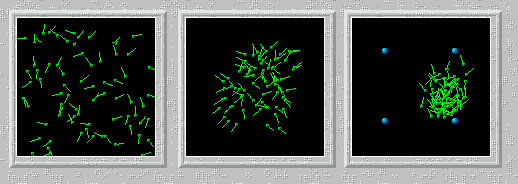
Figure 13.4.3: swarm2.jpg
Composite of Swarm images from Live Artificial Life Page
Robert Silverman has pulled together a first class set of Mathematical
Life Models on his homepage at: http://alife.fusebox.com/cb/alife.html.
This is a very complete compendium of running demonstrations,
including Swarm (pictured above) which allows you to select the
number and size of critters that then attempt to find each other
and swarm together and fly off. Planet Wa-Tor, another Silverman
simulation, pits rabidly hungry sharks against rapidly reproducing
fish as seen in the following figure. Schools of green fish soon
give way to marauding sharks which then starve and the fish return.
These kind of sustainable cycles are common in on-line A-life
ecosystems which can literally go on forever.
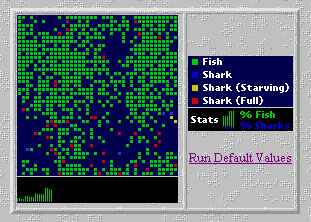
Figure 13.4.4: wator1.jpg
Planet Wa-Tor with its fish and sharks in competition
Craig Reynold's Boids
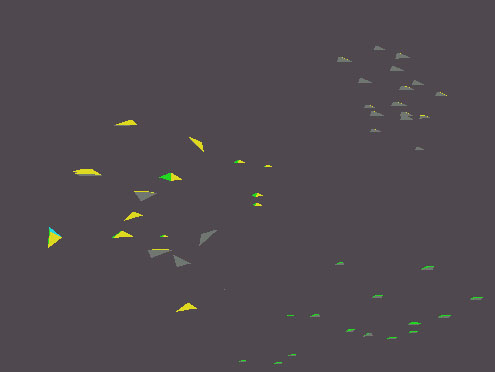
Figure 13.4.5: boids1.jpg
Boids flocking together through Craig Reynold's great Java applet
Craig Reynolds has been fascinated with coordinated animal motion
such as bird flocks and fish schools. Since 1986 he has been creating
models of this behavior in software he calls Boids. Boids
has been used as an inspiration and starting point for lifelike
special effects, particularly the bat swarms in the feature motion
pictures Batman Returns and Cliffhanger as well
as the wildebeest stampede in The Lion King.
In his on-line Boids simulation, the following three simple rules drive the behavior of each individual in the flock:
- Steer to avoid getting to close to neighbors.
- Steer to keep on the average heading of the flock.
- Steer to stay near the average position of the neighbor.
See how Boids runs with these simple rules and read about the
theory and thinking behind it at: http://hmt.com/cwr/boids.html.
Craig tells us that flocking is a particularly evocative example
of emergence: where complex global behavior can arise from the
interaction of simple local rules.
Neural Networks
Many Artificial Life researchers, especially those concerned with
learning and adaptation, endow their organisms with a neural network
which serves as an artificial brain. Neural networks can function
as learning algorithms and may be trained. A typical task of neural
networks is to recognize and correlate images such as human handwriting.
A neural network is composed of a collection of input-output devices,
called neurons, which are organized in well connected network.
In this network, there is an input layer which receives sensory
input, a number of hidden layers which perform computations, and
an output layer through which the results of these computations
are reported. Neural networks can be trained by adjusting the
strengths of the connections between neurons (so that they can
carry different levels of signal or symbols).
The Nerves project described in the section The Synthetic Ecosystems
of Biota.org later in this chapter is an effort to provide neural
networks for virtual worlds and avatars. Neural networks are also
used in the PolyWorld system described in the next section.
Synthetic Ecosystems: the Virtual Terrarium
Synthetic ecosystems are where mathematical life models like those
described in the previous section are put to the test in a large
scale. Imagine thousands or millions of simple forms based on
cellular automata or neural networks going at it in a shared virtual
world full of food, predators and other hazards. Also imagine
that these forms mate and mutate, like creatures in a real world
colony. You will then have what we call a virtual terrarium (or
aquarium, for that matter). We will describe two such terraria
below. A third terrarium, Nerve Garden, will be shown in the next
section in this chapter The Synthetic Ecosystems of Biota.org.
Tom Ray's Tierra
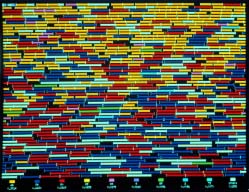
Figure 13.4.6: tierra1.jpg
ALmond interface showing Tierra in Operation
The Tierra Synthetic Life program developed by Tom Ray and the
Artificial Life Monitor (ALmond) program by Marc Cygnus simulate
creatures in digital primordial soup. Tierra is run inside a virtual
computer in order to protect the real computers it is running
on from a hypothetical infection. The ecosystem of Tierra is a
memory space filled by strings representing genomes, which seek
to copy themselves, mutating in the process. The preceding figure
shows us a view of this space, with each creature represented
as a colored bar. In this scene, immune hosts are engaged in a
battle with parasites, driving them into the top of the memory
space.
Tom Ray has been working to run Tierra on thousands of machines
throughout the Internet, creating a "digital biodiversity
preserve". The goal of this preserve is to create a large
environment for digital biota to evolve diverse and complex forms.
Recently Tierra has also been represented in 3D using VRML.
Find the Tierra homepage at: http://www.hip.atr.co.jp/~ray/tierra/tierra.html
and the VRML versions of Tierra at: http://www.construct.net/tierra/.
PolyWorld
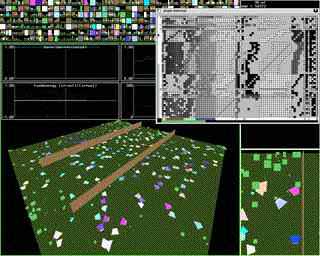
Figure 13.4.7: polyw1.jpg
PolyWorld
Larry Yaeger of Apple Computer developed PolyWorld, a fully featured
synthetic ecosystem in the early 1990s which is today still one
of the most compelling examples of this medium. PolyWorld was
featured along with Tierra in Steven Levy's book Artificial
Life (listed in our Bibliography). Larry has kindly agreed
to give us this description of his work:
PolyWorld is a computational ecology that I developed to explore
issues in Artificial Life. Simulated organisms reproduce sexually,
fight and kill and eat each other, eat the food that grows throughout
the world, and either develop successful strategies for survival
or die. An organism's entire behavioral suite (move, turn, attack,
eat, mate, light) is controlled by its neural network "brain".
Each brain's architecture--it's neural wiring diagram--is determined
from its genetic code, in terms of number, size, and composition
of neural clusters (excitatory and inhibitory neurons) and the
types of connections between those clusters (connection density
and topological mapping). Synaptic efficacy is modulated via Hebbian
learning, so, in principle, the organisms have the ability to
learn during the course of their lifetimes. The organisms perceive
their world through a sense of vision, provided by a computer
graphic rendering of the world from each organism's point of view.
The organisms' physiologies are also encoded genetically, so both
brain and body, and thus all components of behavior, evolve over
multiple generations. A variety of "species", with varying
individual and group survival strategies have emerged in various
simulations, displaying such complex ethological behaviors as
swarming/flocking, foraging, and attack avoidance.
You can download and try the PolyWorld Artificial Life System
and Computational Ecology
see the http://pobox.com/~larryy/polyworld.html.
You must have a Silicon Graphics workstation to run PolyWorld
in its original form, though a pointer to an early version of
a Macintosh port is provided on Larry's web site. Source code
and executables are provided.
Will avatars venture here?
Both Tierra and PolyWorld would probably be very confusing places
for human beings to venture. This is the realm of basic high speed
and highly complex life processes. Future immersive video games
may entice avatars into such worlds, where you are playing the
role of mutator or mutated. More exciting is the prospect that
these synthetic ecosystems could provide the very backbone of
virtual worlds. Please find more on this in the section The Synthetic
Ecosystems of Biota.org later in this chapter.
Some More Live Links
There is so much "A-Life" to explore on the Internet.
These links provide a few more peeks.
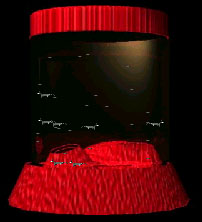
Figure 13.4.8: bi4a.jpg
Sea Monkeys in their element
Sea Monkeys features a fluid drag and semi-realistic physics
system containing 30 sea monkey models moving about with random
motion. See it in the preceding figure and run it at: http://k2.scl.cwru.edu/~gaunt/java/SeaMonkeys/SeaMonkeys.html
Create your own beastie and follow its life cycle at Technosphere:
http://tdg.linst.ac.uk/technosphere/index.html.
Morgan Media's Fish Tank is found at: http://morganmedia.com/m2/shock.html.
You must have a Macromedia Shockwave plug-in installed in your
Web browser to see this. Clicking on models of fish sends them
into the tank. Some fish are carnivorous, and they eat the other
fish. This is a very simple simulated 'ecosystem' but gives you
a quick experience through the Web of something biologically inspired.
Artificial Life Online from the Santa Fe Institute is the
Web companion to MIT's Artificial Life Journal. This extensive
site lists events, publications and hordes of artificial life
software for the Mac, PCs and Unix. Find it at: http://alife.santafe.edu/alife/
Amoebic Lifeforms - Amoeba simulations using Shockwave
can be witnessed at: http://www.csad.coventry.ac.uk/~mep/amoebic.lifeforms/start.htm.
Rudy Rucker's Boppers, an inspired genetic algorithm system,
is available from: http://www.mathcs.sjsu.edu/faculty/rucker/boppers.htm
Alife Garden from Japan at: http://alifegarden.com/
allows you to pick an organism and mutate it right on a Web page
without special software other than your Web browser.
Find Craig Reynold's Artificial Life Links at: http://hmt.com/cwr/alife.html
Marco Maddenings Artificial Life Page is a great and updated
links page at: http://www.wi.LeidenUniv.nl/home/mvdweg/alife.html.
Steven Rooke has provided us with one of the best reference
sections to the people, ideas and further reading in the area
of Artificial Life and Digital Biota at: http://www.concentric.net/~srooke/references.html.
University of Toronto Computer Scientist Demetri Terzopoulos
has researched and published just about every topic in computer
modeling, simulation, artificial life (including artificial fishes!).
Taste a good slice of his work at: http://www.cs.utoronto.ca/~dt/.
A website in support of the Artificial Life newsgroups comp.ai.genetic
and comp.ai.alife is at http://www.krl.caltech.edu/~brown/alife/.
